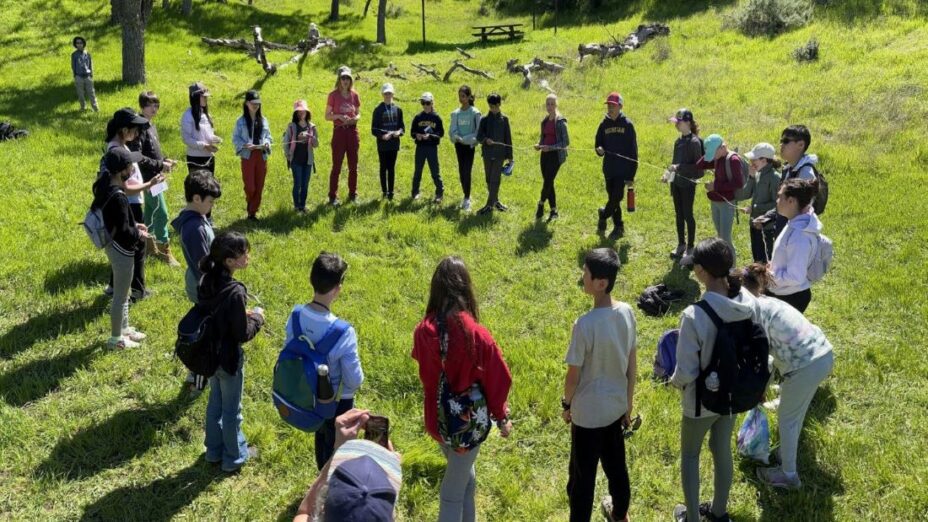
You’ve probably heard the statistics about how kids don’t spend enough time outside these days, and about how much time they spend in the digital world. We’ve been working to change this through our educational work for years.
But until now, our work focused mainly on getting teenagers outside. This year, our mission and goals are expanding.
Save Mount Diablo has been producing a new outdoor education curriculum appropriate for third to fifth graders. At this formative age, it’s vitally important that kids have the chance to connect with and learn from nature in our local open spaces.
Thanks to the work of educators Dawn Lezak, Judy Adler, and others, we’re happy to officially announce the creation of a new educational pilot program with a series of interactive outdoor lessons!
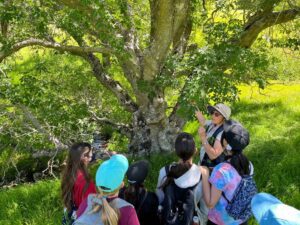
Kids learn how to identify trees through our “Shapes of Leaves” lesson.
“As a veteran teacher, I witness both the benefits and the costs that technology has brought to our younger generations. I believe it is of vital importance that we empower our students by reconnecting them to reality and to the great outdoors,” says Dawn.
“We need to open our classrooms and take our teaching outside so kids can experience nature firsthand. Mangini Ranch Educational Preserve offers the natural setting for a perfect local, hands-on field experience for all ages.”
It’s not just teachers like Dawn who see the importance of outdoor education. The benefits of outdoor education have been well-articulated by kids themselves.
One student remarked, “Learning outside, we can visually see the things that we are being taught inside, instead of viewing it on a screen. I think that learning outside is more beneficial.”
Our goal is to produce a fun and interactive educational curriculum that can be led by teachers who primarily work in the classroom.
These programs will ultimately empower local teachers to take kids outside and facilitate a lifelong love of nature within their students.
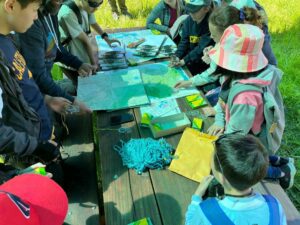
Kids enjoy an interactive cartography lesson at Mangini Preserve.
Over time, these new programs will expand and improve as we work to ensure that these lessons fit the needs of the kids.
We also plan on working with teachers in underserved communities to facilitate outdoor experiences for kids who might have less opportunities to experience nature.
Our pilot program officially kicked off with its first session in April. Led by two experienced outdoor educators, 27 kids got the opportunity to learn at Mangini Preserve when the hills were at their greenest and Galindo Creek was filled with flowing water.
Our new programs cover various important topics including cartography, plant identification, and the history of the Native Americans and ranchers who inhabited Mangini Preserve.
As we continue to work on our programs, we plan on adding fun and memorable lesson plans that will teach kids about land stewardship and local fungi.
After experiencing the pilot program, another student said, “In the classroom you just sit there, and when you are outside, you can see in front of your eyes and see what they are talking about, and you’re outside, which helps.”
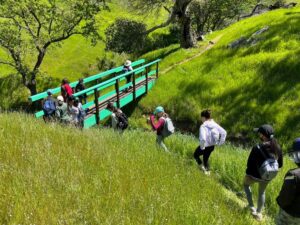
Kids in the pilot program cross Galindo Creek. In this program they learn about the importance of the creek and the interconnectivity of the systems it helps sustain.
An educational program that gets kids outside like this has a long list of benefits, particularly for kids who may struggle within a traditional classroom setting.
“Students with ADD and ADHD in particular seem more centered and content when I am working with them outside in the school garden or taking them on a hike,” says Dawn.
“They are often the ones making discoveries, and seeing nuances that other students did not notice.”
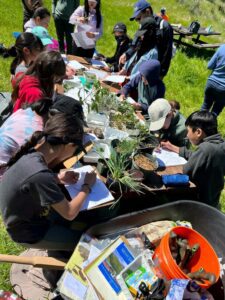
One of our new lessons in action at Mangini!
By teaching students outdoors, the lessons will be more memorable and enjoyable.
Instead of spending another long day at their desks, kids will be able to spend time learning through exploration and action.
While they work on mastering the topics of each lesson, they practice teamwork and problem-solving skills in a new environment.
This program was funded through the Adler Education Fund, which was initiated by a challenge grant from renowned environmental educator and Save Mount Diablo Education Committee member Judy Adler.
Photos courtesy of Dawn Lezak

